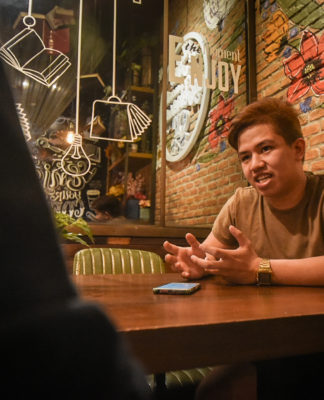Patient: Doctor, I have stomach ache
Doctor’s prescription:
2000 B. C. — “Here, eat this root”
100 A.D. — “That root is heathen, say this prayer”
1850 A.D. — “That prayer is superstition, drink this potion”
1940 A.D. — “That potion is snake oil, swallow this pill”
1985 A.D. — “That pill is ineffective, take this antibiotic”
2000 A.D. — “That antibiotic is artificial. Here, eat this root”
—From History of Philippine Medicine
FOR CENTURIES, man has pushed the limits back in every aspect of his life, constantly going further after he has reached a particular point or conquered a certain barrier. His leaps in the field of medicine, for example, have improved the quality of living.
Or have they? In recent years, more and more medical experts have resorted to traditional or alternative medicine after having studied and verified its healing properties. And a wave of enthusiasm has captivated the public; it seems people are more ready to go natural rather than risk the side effects of “artificial” drugs.
Is this a return to square one after braining breakthrough after breakthrough? Does the high cost of even the most advanced and certain medical innovations have something to do with people going back the old ways? Or has traditional medicine finally proven its worth and reclaimed lost glory?
In the beginning
For thousand of years, trial and error was the key to discovering the medicinal properties of plants. Minor ailments like colds and constipation were treated using herbal remedies. However, medical practice relied not only on folk medicine but religious and cultural norms as well. Diseases that could not be remedied by simple herbs were placed in a different category. Believing such diseases were supernatural in origin, the treatments applied were also “extraordinary”—luring the errant soul back into the body or extracting the “evil intruder” using counter spells, incantations, potions, suctions, and other means.
In extreme conditions where “quack” medicine is ineffective, the skull of the sick person was cracked open to provide an exit point for the demons or the bad elements. This was called trephining, which fortunately is no longer practiced today.
Philippine folklore
Alternative medicine in the Philippines is a reflection of its people’s origin— an amalgam of cultures and influences. Centuries of the Spanish regime, the hundreds of years of barter trade with the Chinese before that, and the eventual assimilation of their healing arts—all fused into the Filipino’s easy disposition for superstition and the allure for things mystical.
Some of the more prominent practices in alternative medicine are still evident in the country today.
A hilot is a midwife or a chiropractor or the one who treats both muscle-joint (muscololigamentous) and muscle-bone (muscoloskeletal) by manipulating the joints of the body as well as other diseases and ailments.
The massage aims to manipulate the spiritual and energy channels, hoping to expel evil spirits that may have invaded the body.
Another traditional practice is herbal therapy, or the use of herbs for various illnesses. Considered a replacement for unaffordable and prescription drugs, herbs and the leaves of plants are boiled and taken as tonic or applied directly to affected areas in the body.
Herbolaryos (folkdoctor), referred to as Imedicos, are popular especially in the rural areas. They often mix an extensive array of alternative therapies with varying doses of religion, magic, and even an occasional sprinkling of pharmacy-based medicine.
And then there is faith or psychic healing. Psychic healers allegedly can do surgery with their bare hands. Or they slit open the skin, remove “diseased organs and tissues” and close the opening without sewing—finishing surgery without a trace, “miraculously” curing the patient.
In his book “Faith Healing in the Philippines,” Jaime Licauco, a renowned psychic and expert in paranormal psychology, extensively described healing practices in the Philippines as a form of charismatic work done in a state of emotional and religious fervor.
Finally, of Chinese origin, acupuncture mainly revolves on the “yin-yang” philosophy, which states that energy can be channeled to areas of the soul that needs recharging. The technique makes use of pins and needles inserted in specific and anatomically strategic pressure points.
Doctors speak
According to faculty members of the UST Faculty of Medicine and Surgery, the Association of Philippine Medical Schools has made it mandatory to incorporate the study of certain alternative kinds of medicine in the curriculum. However, the University only recognizes acupuncture and herbal medicine, which are included in the medical curriculum. Acupuncture is taught in one lecture under anesthesia and the use of medicinal plants is tackled in pharmacology.
USTH Health Service director Dr. William Olalia said that alternative kinds of medicine are not practiced in a tertiary education hospital setting like in UST Hospital. They are practiced only in the provinces.
Meanwhile, the B.S. Botany program of the Faculty of Pharmacy has been scrapped and will no longer be offered next year. Unconfirmed reports from the Faculty have it that a B.S. in Traditional Medicine will be offered in its place.
Disastrous combination
According to the “History of Philippine Medicine,” the alternative method of medicine is considered a holistic approach. Recently introduced in the country, it simply acknowledges that there may be something good in every curative method and that a patient should be given a chance to try it especially when western medicine has failed. Present-day medical science has often times failed to explain alternative medical methods, which are deemed unacceptable in the medical profession, but sometimes tolerated.
Would there ever be an “integrative medicine” which would unite the best of both worlds, marrying scientificallyproven chemotherapy, for example, with herbal formulas?
It is in this light that UST doctors agree that there is though a remote possibility, of the marriage between the two different philosophies.
So, what will doctors answer to, “Doctor, I have SARS”?
Well, they can just fill in the blanks for now.
















